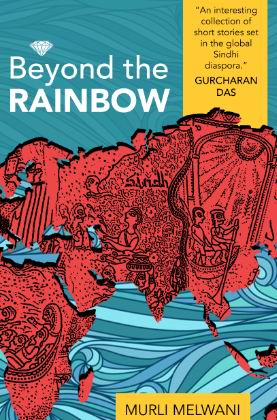
For more than a hundred and fifty years, members of this diasporic community have not hesitated to set sail and embark on voyages to new, often unknown, destinations to break into new markets, facing the resulting challenges with equanimity.
By Saaz Aggarwal
Is there any country in the world that has no Sindhi in it? Perhaps – But the cover of this book has presumed to show every country in the world firmly occupied with symbols of Sindh and Sindhiness.
These images were kindly provided by the inimitable Sapna Moti Bhavnani, in the form of photographs of the tattoos on her body. They depict incidents she was told about life in Sindh, and her family’s experience of Partition.
One of their themes is ajrak, an icon of Sindh and Sindhiness.
Ajrak is the name given to a traditional block-printed design of Sindh used on fabric and tile, most often rendered in dark red and dark blue. In Sindh, it is a tradition to drape respected guests with cloths of ajrak, and this leads to a special reverence for ajrak as a design, and for specific ajraks gifted by revered people or special family members.
To drape the world map with ajrak is a nod to Murli’s community: the Sindhis who live in many places around the world and have integrated into local communities, speaking local languages, participating in local religious traditions, offering charity to the local underprivileged, and, to an extent, even intermarrying into the local community.
Watch the Video: Bootless but bound by ties
For more than a hundred and fifty years, members of this diasporic community have not hesitated to set sail and embark on voyages to new, often unknown, destinations to break into new markets, facing the resulting challenges with equanimity. The dynamic and intricate waves represent their brave and adventurous spirit – but also their essential interconnectedness in every aspect of business and lifestyle.
Sindh itself, the ancestral homeland of the Sindhis from which they were rudely dispatched in 1947, having lost not just all they had but even more than they could imagine, is seen here integrated into the countries of the world, a nod to a community that may have been uprooted but have retained ties that bind them to each other. Far away from Sindh, they remain proud to call themselves Sindhi, and resolutely clutch at tangible aspects of their ethnicity, even as their language and culture irretrievably drain away.
As for the diamond … aah, everyone knows about Sindhis and those things. In contemporary times, they are far more an icon of the diasporic Sindhi community than ajrak. And it was only fitting that, like the nearly-mother-in-law Mrs. Parnani in The Bhorwani Marriage, this cover should have “EVERYTHING”.
_________________
Courtesy: Saaz Aggarwal/ Sindh Stories
 Saaz Aggarwal is an independent researcher, writer and artist based in Pune, India. Her body of writing includes biographies, translations, critical reviews and humour columns. Her books are in university libraries around the world, and much of her research contribution in the field of Sindh studies is easily accessible online. Her 2012 Sindh: Stories from a Vanished Homeland is an acknowledged classic. With an MSc from Mumbai University in 1982, Saaz taught undergraduate Mathematics at Ruparel College, Mumbai, for three years. After a career break when she had a baby, during which time she established a by-line as a humour writer, she was appointed features editor at Times of India, Mumbai, in 1989, where she launched Ascent, the highly successful HR pullout of the Times of India Group. From 1998 to 2006, she was HR and Quality Head of Seacom, an Information Technology company based in Pune. As an artist, she is recognized for her Bombay Clichés, quirky depictions of urban India in a traditional Indian folk style, as well as a unique range of offerings at the annual Art Mandai event in Pune. Her art incorporates a range of media and, like her columns, showcases the incongruities of daily life in India.
Saaz Aggarwal is an independent researcher, writer and artist based in Pune, India. Her body of writing includes biographies, translations, critical reviews and humour columns. Her books are in university libraries around the world, and much of her research contribution in the field of Sindh studies is easily accessible online. Her 2012 Sindh: Stories from a Vanished Homeland is an acknowledged classic. With an MSc from Mumbai University in 1982, Saaz taught undergraduate Mathematics at Ruparel College, Mumbai, for three years. After a career break when she had a baby, during which time she established a by-line as a humour writer, she was appointed features editor at Times of India, Mumbai, in 1989, where she launched Ascent, the highly successful HR pullout of the Times of India Group. From 1998 to 2006, she was HR and Quality Head of Seacom, an Information Technology company based in Pune. As an artist, she is recognized for her Bombay Clichés, quirky depictions of urban India in a traditional Indian folk style, as well as a unique range of offerings at the annual Art Mandai event in Pune. Her art incorporates a range of media and, like her columns, showcases the incongruities of daily life in India.